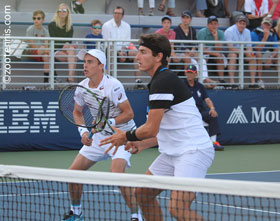Special Feature
Countdown: Fitting In Doubles Proves Challenging
by
Colette Lewis, 24 March 2017
| Share: |  |
|  | |
|
|
Doubles is:
- fun to play and watch,
- an appetizer for singles play,
- a vehicle for juniors to improve their games,
- a key point in a Division I dual match,
- a scheduling nightmare

Doubles is played using a dizzying number of different formats
©
Zoo Tennis The correct answer, of course, is all of the above, demonstrating why settling on one scoring format for the four-person version of the game has proven impossible.
The professional tours moved to no-ad scoring and a match tiebreaker in lieu of a third set to provide a shorter, more reliable time frame for doubles competition, although the four slams have resisted adopting that format except in mixed doubles. The ITF Pro and Junior Circuits also play the WTA and ATP format, but the USTA has never endorsed it for their events.
But when NCAA Division I tennis went to an even more radical format - one standard tiebreak set with no-ad scoring - in an effort to shave time from its dual matches, the USTA chose to follow that lead, now using it at National Level 2s and at the new Level 1 National Indoor Championships coming this November. Doubles is abbreviated even more at USTA National, Intersectional and Zonal Team Championships, which play no-ad with a tiebreaker at 5-all, not 6-all.
Other USTA Level 1 events have additional variations, none of which involve no-ad scoring. The USTA National Doubles Championships [for 14s and 16s age divisions] employ best-of-three tiebreak sets, while other USTA National Championships switch from a match tiebreaker in lieu of a third set to a standard best-of-three format after the quarterfinals.
Each of these formats can be viewed as the solution to a specific problem, but the net result is less doubles being played per tournament - which may turn out to be an obstacle to the USTA's mission of growing the game.
Truncating doubles does allow tournament directors more leeway in scheduling, permitting more matches to be completed in a single day while still providing adequate rest. But has the emphasis on singles gone too far?
Maria Cercone, now manager of junior competition for the USTA Southern section, is able to look at the issue from all sides. A player development coach, a tennis parent and a tournament director in Florida for 35 years, Cercone is also a member of the USTA's Junior Competition Committee.